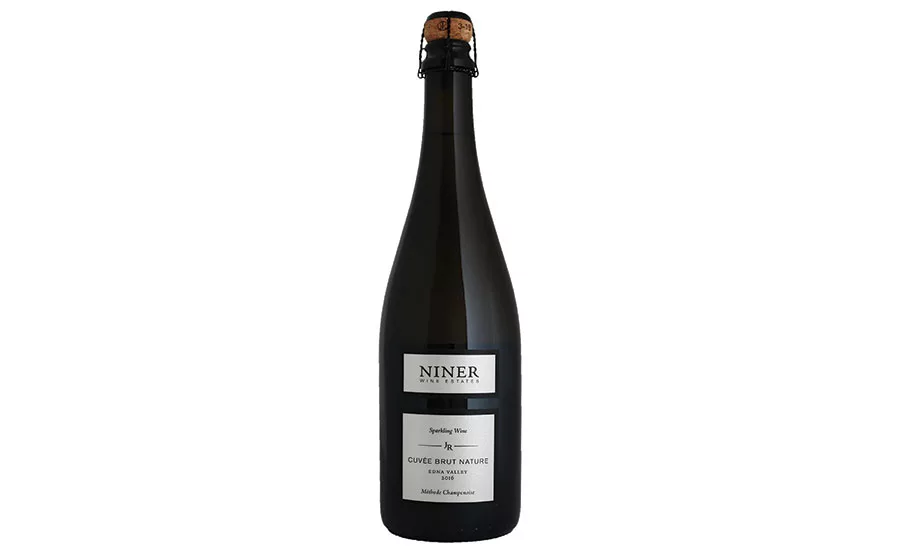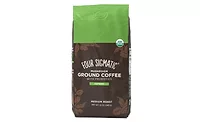Growth-driving trends impacting wine category
Sparkling wines, packaging, digital ordering impacts sales

Niner Wine Estates recently released Cuvée Brut Nature, a premium sparkling wine with no added sugar. (Image courtesy of Niner Wine Estates)
Swings and shifts impacting the wine category are ongoing, and with recent trends influenced by factors such as preference, packaging, taste and technology, continuous shifts are changing the way wine is made and marketed.
Silicon Valley Bank’s (SVB) 2020 State of the Wine Industry Report states acute oversupply with diminishing volume growth in demand will lead to widespread wine discounting, presenting consumers with the best wine retail values in 20 years.
"Today, the wine supply chain is stuffed," said Rob McMillan, founder of SVB’s Wine Division and author of the report, in a statement. "This oversupply, coupled with eroding consumer demand, can only lead to discounting of finished wine, bulk wine and grapes. U.S. wine consumers will discover unprecedented retail value in 2020 and should buy up."
However, wine holds a firm place in the beverage market; U.S.-based Global Market Insights (GMI) Research Content Developer Saloni Walimbe says consumption in the U.S. stood at 966.09 million gallons in 2018, an increase from the 894.23 million gallons consumed in 2013.
Chicago-based Information Resources Inc.’s (IRI) Client Insights Director Cara Piotrowski notes that the total wine market, table and sparkling, reached $12.2 billion in sales in U.S. multi-outlets and convenience stores for the 52 weeks ending Dec. 1, 2019. However, she adds that wine has softened with just 2.2 percent year-over-year dollar growth, with volume growth declining by 0.5 percent for the first time in three years.
The International Wines and Spirits Record (IWSR) Drinks Market Analysis notes a similar downturn in volume. The global beverage alcohol market intelligence firm reports that total wine in the United States decreased in 2019 for the first time in 25 years. Although sparkling wine volume sales were up 4 percent in 2019, this did not offset the 1.5 percent volume decrease for the larger still wine category, IWSR reports. “The last volume loss in the category occurred in 1994, marking 24 years of growth before this most recent decline, and is attributed to changing generational habits,” the market research firm states.
(Individual brands)
| DOLLAR SALES | %CHANGE VS. PRIOR YEAR | CASE SALES | %CHANGE VS. PRIOR YEAR | |
| Barefoot | $655,263,527 | -1.3 | 9,672,618 | -3.2 |
| Sutter Home | $390,875,884 | 0.1 | 5,629,096 | -3.4 |
| Woodbridge by Robert Mondavi | $349,260,214 | 0.2 | 5,285,213 | -0.8 |
| Franzia Box | $342,395,691 | 3.1 | 12,242,917 | 0.8 |
| Yellow Tail | $259,835,828 | -3.2 | 3,916,792 | -3.5 |
| Black Box Wines | $246,323,236 | 6.1 | 4,020,930 | 3.4 |
| Josh Cellars | $235,224,981 | 27.8 | 1,545,011 | 27.7 |
| Bota Box | $206,841,205 | 21.1 | 3,685,754 | 21.5 |
| Kendall Jackson Vintners Reserve | $202,113,808 | 1.5 | 1,411,506 | 1.9 |
| Apothic | $190,745,248 | -1.4 | 1,624,025 | -2.2 |
| Total sales* | $10,643,888,170 | 1.5 | 126,460,003 | -0.9 |
*Includes brands not listed.
Source: Information Resources Inc. (IRI), Chicago. Total U.S. supermarkets, drug stores, mass merchandisers, gas and convenience stores, military commissaries, and select club and dollar retail chains for the 52 weeks ending Dec. 1, 2019.
Imported versus domestic
Danny Brager, senior vice president of beverage alcohol at New York-based Nielsen, reports that overall table wine grew 0.9 percent for the 52 weeks ending Nov. 2, 2019, with domestics dominating growth.
The growth of domestic wine indicates promise for the channel, particularly since recent tariff modifications could impact imported wine, GMI’s Walimbe says.
“Domestic table wines are a fundamental growth-driver for the U.S. wine market, with newly imposed tariffs slightly blurring the business outlook of imported wines,” Walimbe explains. “The domestic wines segment holds a considerable percentage of the overall table wines market sales via off-premise outlets.”
IRI’s Piotrowski says domestic table wine grew 1.5 percent compared with the previous year, however, imported table wines grew faster at 2.8 percent compared with the previous year.
Sparkling on the rise
When it comes to the types of wines resonating in the wine category, experts note that certain varietals are driving growth. Although Chardonnay had performed best domestically, Cabernet Sauvignon regained the top spot this year, according to GMI’s Walimbe.
IRI’s Piotrowski notes that Rosé, Sauvignon Blanc, Prosecco and Pinot Grigio are next in line and are popular because of their sweeter, fruit-forward, approachable flavor profiles.
Wine preference also varies by demographic. Chicago-based Mintel reports that millennials and Gen Xers prefer fruity, sparkling and specialized wines.
According to GMI’s Walimbe, the most prominent sparkling wines are Rosé and Prosecco.
“With respect to sparkling wine, the U.S. is one of the largest markets across the globe,” Walimbe says. “The industry has shown steady growth, both in the short- and long-term, pertaining to sales volume as well as per-capita consumption.”
IRI's Piotrowski agrees, “Sparkling wine trends, namely Prosecco and Rosé, drive significant growth for imported wine and continue to see strong year-over-year growth.”
Piotrowski adds that sparkling wines are ahead of the total market, with accelerated sales and volume growth of 8.1 percent and 5.7 percent, respectively, compared with the previous year.
Andy Niner, president of Niner Wine Estates, Paso Robles, Calif., says creating a premium product led to the company’s recent Cuvée Brut Nature, a zero-added-sugar sparkling wine.
“Strategically, it’s a wonderful way for us to highlight both the quality of our vineyard and our approach,” Niner says. “We are all-estate, so offering a sparkling wine for which we took time to control every aspect of the process is rewarding and shows our commitment to doing things right.”
Preference for premium
Premium wines are trending, with increasing disposable income denoted by the growth of higher-priced domestic table wines, experts note.
“Premium-priced wine products fulfill consumer needs for flavor/varietal while increasing accessibility for convenient consumption, leading to its continued growth,” IRI’s Piotrowski says. “Shoppers gravitate to premium wine products, and yet, price growth has modulated recently for these premium-priced wines.”
Piotrowski says dollar sales for table wines priced $11 or more and sparkling wines priced $13 or more collectively grew 8.4 percent compared with the previous year. Luxury table wine priced between $20-$24.99 was the fastest growing segment at 10.2 percent, she notes.
The overall perception of wine consumption also has affected consumers’ spending thresholds.
“Many nations are now shifting from daily wine consumption to occasional consumption,” GMI’s Walimbe says. “With wine perceived [as] more of an occasional indulgence, the U.S. population is open to spending higher amounts for premium wines when dining out.”
California and beyond
Whether grapes are grown in the United States or internationally, wines from various regions continue to evolve. For instance, outside of U.S. borders, Walimbe says that Ribera del Duero and Rioja wines from Spain are gaining prominence across the United States.
“Portugal is also witnessing steady growth in both value and volume with winemakers and importers working hard to change consumer perception of the region’s reputation as a lower-end winemaker,” she explains. “Sauvignon Blanc from New Zealand is thriving and wines from France remain popular in the U.S. market, with France shipping a massive number of bottled table wine cases to the U.S. last year.”
Closer to home, California remains the foremost wine-producing state, Walimbe says, accounting for approximately 89 percent of the American wines, according to the World Atlas. Washington is the second largest wine-producing state, housing nearly 9 percent of U.S. wineries, and accounting for about 4 percent of total U.S. wine production.
However, IRI’s Piotrowski says Oregon tails California in growth with 15.3 percent growth compared with the previous year.
The next beverage boom
Nandini Roy Choudhury, senior research consultant at London-based Future Marketing Insights, says consumer trends regarding environment-friendly, on-the-go and single-serve packages have resulted in consumers expecting manufacturers to offer wine in consumer-friendly containers. She notes wine in single-serve, 175- and 350-ml cans are becoming popular with consumers because of their portability.
“The fun packaging and easy-to-use factors have made this popular among Gen Z,” Choudhury says. “Among the millennials, boxed wine and subscription packs are trending, becoming the talk of the party.”
Experts predict canned wine and wine-based cocktails will grow in 2020 and beyond. Wine-based cocktails experienced double-digit 43.5 percent growth in the 52 weeks ending Nov. 2, 2019, according to Nielsen’s Brager.
IRI’s Piotrowski says that wines in cans sold $86.7 million in 2019, a 91.7 percent increase over the prior year. She says this is partially because alternative packaging, such as cans, improves accessibility to affordable premium wines, promoting trial among variety-seekers.
Yet, she notes the impact offers positive and negative results.
“Alternative packages can drive trial, increase occasions and source wine volume from other beverages. However, there is a potential volumetric impact when consumers replace 750-ml bottles with single-serve cans,” Piotrowski explains. “Additionally, not all wine brand equities benefit from alternative packaging, requiring marketing departments to determine which package offerings deliver the most value to their consumers.”
Another trend impacting wine consumption is off-premise purchasing online and via delivery apps. In 2019, the eCommerce channel in the 10 core markets studied by the IWSR was estimated to hit almost $21 billion. By 2024, IWSR forecasts that the channel will be worth $45 billion, outpacing the growth rate of total trade during the next five years.
“Technological advancements are expected to make wine shopping a seamless and fascinating process,” GMI’s Walimbe says. “This growing propensity toward online wine shopping, in tandem with the advent of wine delivery services from leading stores, is likely to present several lucrative growth prospects for the wine retail industry.”
Mintel’s November 2019 report titled “Wine – US” agrees, adding that a broad distribution model is imperative to targeting convenience-driven millennials, and should include online and delivery channels because millennials are more than twice as likely to purchase wine online and four times as likely via delivery services.
“The rise of mobile apps as a key source for learning about, buying and getting wine delivered is likely to revolutionize how wine is sold in the years ahead,” the report states. “The sooner suppliers and retailers embrace these tools, the better positioned they will be to meet young consumers who are already there.”
Key takeaways for 2020
Experts note that shoppers are seeking flavorful offerings across all beverage alcohol categories, indicating continued growth and innovation in flavor-forward wine beverages. Sparkling wines remain a breeding ground for this innovation. Premium-priced wine will leverage alternative packaging opportunities, with more varietals available in non-bottle form. And finally, brands can benefit from implementing digital purchasing options with strategic marketing that drives consumers to those platforms.
"The key to future success for U.S. wineries will be in cracking the millennial code to understand that evolving consumer profile,” SVB’s McMillan said in a statement. “Today, there are winners and losers in the wine trade. The winners are those with solid management teams who are willing to evolve their sales and marketing strategies, execute quickly on a plan, then evaluate success or failure to continuously improve." BI
Looking for a reprint of this article?
From high-res PDFs to custom plaques, order your copy today!






